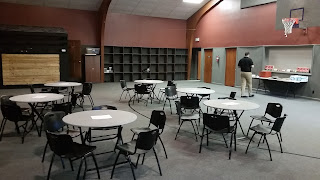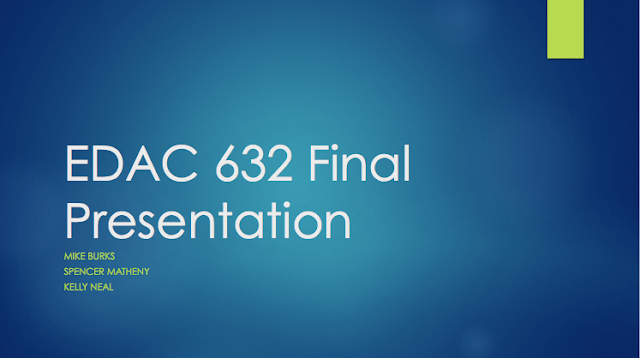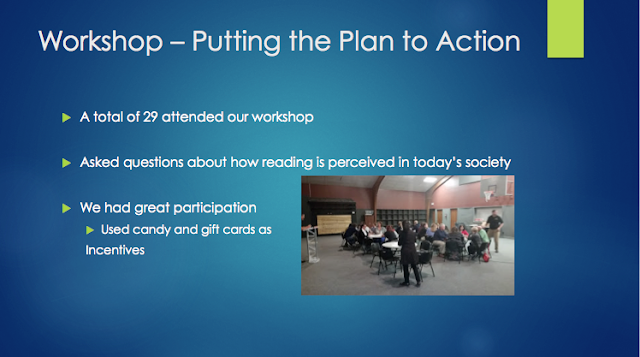Our workshop was a very successful
one. We had a total of 29 members of the community attend. We had two main
goals for our workshop. We wanted to spread the word about The Big Read. We did
this by listing many steps on how to support and spread the word about The Big
Read. We asked them if they enjoyed their time at the workshop to show their
support by telling more people and going to more workshops. We wanted to expand
The Big Read’s relationship with the people of he community (Gordan, 1998). The
more people that hear about it the more they will be inclined to help the
cause. We also wanted to create a learning environment for our workshop attendees.
We wanted to show them how reading is important and vital to our lives today.
We wanted them to see that we should still be reading in our daily lives.
With our purpose set for the
workshop, we also had to set some goals to make it successful. We wanted to
create a positive environment for the attendees while also keeping it an
educational venue. I believe we achieved these goals. There was a lot of excitement
surrounding the attendees at our workshop. It was great to see the excitement
as well as the learning that was taking place. We created incentive for
participation in the workshop by providing prizes if questions were answered
correctly. This ensured the participants to make sure they were gathering all
of the information they could so they could get the prize. The workshop was a
great success. Many attendees said they liked it and would attend another
workshop.
Just
like with the marketing plan we had to be able, as a group, figure out our
strengths and weaknesses. Which member can do this and which member can do
that. Once we established those skill sets we then started to plan which member
had certain roles. To start from the beginning, we had to find a place to host
our workshop. This has to be one of the first steps because then we were able
see what resources were available for us to utilize. Once we had this
established we then thought of what activities we could create so that we could
inform our participants and draw them in to attending our workshop. As a group
we met and discussed what needs needed to be met not only for us, but our
participants and learners as well. It is an important aspect in any workshop
that you outline certain needs of either the participants or yourself (Brown
& Keeley, 1988). Once you can define those needs you can think of ways to
conduct your workshop to enlighten your guests and participants. As a group we
decided that we wanted to have different incentives for the participants which
included food and prizes.
If people know they have a chance at either getting
free food and possibly free prizes it can draw them into coming. We were able
to do these things because of the venue that was provided for us. According to
Duvall (1951) planning ahead to see if there can be any type of activity or
food provided is a key step into making a workshop successful. We were also
able to utilize our budget very well. For the actual workshop, we wanted to
create an environment to where the participants had a sufficient amount of time
to engage in discussions with each other as well as be involved in activities.
We did not want the workshop to be of the lecture type because lectures shouldn’t
be the main focus for a workshop (Brown and Keeley, 1988). That why we were
able to introduce ourselves as well as discuss The Big Read and the book,
Fahrenheit 451, in a timely manner. We created activities that started off
having groups of people introduce themselves
because
if they can know a little information about each other they can get comfortable
with one another to where they will participate together in other activities.
As a group we also planned that evaluation will be a huge part for our results.
We wanted to create survey to give to our participants to see if there need to
be changes, improvements, what are our weaknesses and strengths, etc., that way
if we every conduct another workshop we can make it even better.
Our groups were allotted a
total budget of $100.00 for our workshop.
Budgeting of an event is one key to the success of any organization,
Matkin (1985) states that budgeting is “a process of planning the future
operations of an organization and systematically comparing those plans with
actual results” (p.5). It was important
that our group come together and determine a working budget so as to keep track
of all fixed and variable expenses for the workshop. For this event we used the process of
Expenditure Budgeting, Galbraith (1997) expresses this as the process of
keeping track of how all resources will be spent, to keep track of all
financial transactions.
Our workshop was held at Glad
Tidings Student Ministries Center located 3001 S. Burlington Dr. Muncie,
IN. Glad Tidings has a separate facility
that they use for their school aged services, that is located directly next to
their main worship center. We were able
to secure the venue for a cost of total cost of $40.00, this included usage of
all spaces as well as technical support from the Glad Tidings
representative. As Glackin (2009) would
ascertain “hosting a well-run, well attended training workshop requires time
and staff resources” (p.76). By having
the full resources of Glad Tidings at our disposal, we could be assured that
all things would be taken care of facility wise.
To promote the event, the bulk
of promotion was handled through our Facebook pages. With over 200 friends viewing posts about the
Big Read, we were happy with the coverage of our promotions but knew there
could be more. We decided to use $20.00
of our budget on additional marketing by creating flyers. These flyers were developed with our partner,
Integrity Fulfillment Services (IFS), to create 200 flyers to handout
locally. Our intentions were to provide
additional ways to spread the word about our workshop, and at 10 cents per copy
this was a relatively cheap way to reach a larger audience. Our marketing campaign has always looked at
reaching the largest number possible, knowing that not everyone will attend our
event, but just seeing our information will increase awareness for the Big Read
in general. In the end our generous
partner at IFS was able to donate the entire printing session for the cause of
the Big Read, thus allowing our entire marketing effort to cost $0.00.
Our group had discussions on
what options would help to attract patrons to our workshop, and food seemed
like the logical #1 option talked about by each member. We first had to determine the total number of
participants that we anticipated showing up.
We were able to determine this via our marketing plan (Facebook). By creating a FB event and having people
signup to attend, we were able to only purchase the quantity of items needed
for that many people. Because we had
just over 20 sign up for the event, we decided to purchase enough food,
desserts and drinks for 25-30 people to be safe. Table #1 shows our initial projections of the
budget per person attending the workshop.
From this number, we were able to determine what foods or snacks that we
could offer for the event. It was
determined that pizza would fit within our budget, allowing for each person to
have two slices of pizza each. We
partnered with a local culinary program to provide the additional snacks at no
cost. Other items like water, utensils,
give-a-ways and napkins were purchased at the local Walmart.
Table #2 shows our final expenditures
for the event, as it shows our final dollar spent on the workshop was $127.13
for a total of $4.38 per person spent.
Further we were able to do a breakdown of total monies spent on specific
categories such as; marketing, food, give-a-ways. This breakdown resulted in a dollar amount
per persons reached as seen below.
Total $ Allotted
|
Number of Participants
|
$ / Per Person
|
$100.00
|
20
|
$5.00
|
Category
|
Price
|
Quantity Served
|
Price / Per
|
Facilities
|
$40.00
|
29
|
$1.38
|
Marketing
|
$0.00
|
419
|
$0.00
|
Food
|
$47.13
|
29
|
$1.88
|
Give-a-ways
|
$40.00
|
29 (eligible)
|
$1.38
|
Workshop
Activities and Results
We centered our workshop on the
idea of open discussions about reading in general. The thought was to gauge, if and why, people
read less today than in the past. The
Fahrenheit 451 book would be mentioned, but not be the central point of the
workshop. Creating meaningful discussions
and adding interest in the Big Read as a whole was our theme. Attendees arrived (a total of 29 people), and
we collected information and had them sign a waiver for participation and photographs. We invited them to sit at a table of their
choosing. Some of our attendees already
knew each other, but for many the event was an opportunity to meet new
people. We determined that feeding our
audience first would help create the open dialog that we desired. We set our workshop up in small circular
table to allow conversation tableside, as well as in a group (See Picture #1).
After giving groups time to
visit the food table (See Picture #2), we then held the opening
conversations. Our team introduced
ourselves, and gave brief information on the events of the evening followed by
information about Fahrenheit 451 and its author Ray Bradbury. Little did the attendees know, this
information would come in handy for final prize give-a-way which ended in a tie
(See Picture #3).
Initial conversations centered
on reading, and its place in modern culture.
Questions were asked about people’s favorite books, how often they
currently read and have their opinions of reading changed over time. The groups were then instructed to work with
the groups that had assembled at each table to discuss reasons or excuses
people use to not read. Groups were
instructed to write down their top 7 answers.
It was a truly positive
experience to hear people of differing ages and experiences discuss their
reading habits. After 10-15 minutes of
discussion each group was introduced to a Family Feud style game in which the
top 7 answers were revealed. Two teams
ended up in a tie for the win, with the tie breaker being a question from the
opening remarks.
As the evening wrapped up, each
attendee was instructed to take out the number card that was assigned to them
when they arrived. We then drew for giveaways
which ranged from small gift cards, Fahrenheit 451 book or candy. After all the items had been dispersed to the
audience, we asked that each person at the table would fill out an exit survey
which asked questions pertaining to their reading habits.
The intentions of our survey
were to gauge participants’ reactions to reading in general, as well gaining
insight into the success of our workshop.
Glackin (2009) describes a surveys purpose in a workshop as a means to
“offer insight into what went well and what did not” (p.87). The results of our survey (See Chart #1),
suggest that the majority of our participants currently spend less than 4 hours
per week reading, but 67% responded that they are more inclined to read more
after attending the workshop.
Additionally, 44% suggested that they would like to attend additional
Big Read events in our community.
Chart #2 (Survey Results)
|
0-1
|
2-3
|
3-4
|
4
or More
|
How many
hours a week do you read on average?
|
50%
|
25%
|
15%
|
10%
|
|
Strongly Agree
|
Agree
|
Somewhat Disagree
|
Strongly Disagree
|
I am
inclined to read more after attending this workshop
|
22%
|
45%
|
33%
|
0%
|
|
Strongly Agree
|
Agree
|
Somewhat Disagree
|
Strongly Disagree
|
I want
to Participate in more Big Read activities after attending this event
|
20%
|
24%
|
30%
|
26%
|
Looking back, our workshop was
a great success. We had everyone participating in our workshop activities. The
most significant part was when asked the participants to fill out the survey at
the end of our presentation. This will allow us to look back and see what
people enjoyed and what they did not. We will be able to take this information
and apply it to The Big Read. This way we can spread the word and get people in
the community reading again.
 |
| Picture 1 |
 |
| Picture 2 |
 |
| Picture 3 |
Workshop Table
|
1.
|
Purpose
|
To create a successful and meaningful Big Read workshop that
encourages community members to read more frequently.
|
|
2.
|
Goals
|
·
Have a minimum of 20 community members attend
·
Increase the likeliness of the attendees to
read more often
·
Spread the word about The Big Read
|
|
3.
|
Workshop
Plan
|
Introductions – Spencer Matheny, Mike Burks, and Kelly Neal
Background on The Big Read – Mike Burks
Ray Bradbury and Fahrenheit 451 information – Kelly Neal
Conversation about favorite books – Spencer Matheny
Top 10 reasons we do not read contest – Spencer Matheny
Prizes and handouts – Mike Burks, Spencer Matheny, and Kelly Neal
|
|
4.
|
Workshop Activities
|
·
Talk about The Big Read and how to attend
later events and support
·
Give a backstory to Ray Bradbury and Fahrenheit
451
·
Ask attendees about their favorite book and
describe it to their group
·
Have groups work together to write the top 10
reasons people do not read anymore
·
Give prizes at the end
|
|
5.
|
Workshop Results
|
The workshop was a great success. We had several people ask us about
The Big Read afterwards. The survey told us that 22% of the attendees were
inclined to read more after the workshop while 20% wanted to attend another
Big Read Workshop.
|
|
6.
|
Budget
|
Facilities $40.00
Marketing $0.00
Food $47.13
Give-a-ways $40.00
Total $127.13
|
References
Barbara C. Glackin & Cheri
A. Folkner (2009): Planning, Organizing, and Hosting a Workshop—It's All in the
Details, Cataloging & Classification Quarterly, 47:1, 74-89
Galbraith, M., & Sisco, B.
(1997). Administering successful programs for adults: Promoting excellence in
adult, community, and continuing education (Original ed.). Malabar, Fla.:
Krieger Pub.
Gordan,
I. (1998). Relationship marketing: new strategies, techniques and technologies
to win the customers you want and keep them forever.
Browne,
M., & Keeley, S. (1988). Successful Instructional Development Workshops.
College Teaching, 36(3), 98-101.
Duvall, E. (1951). Steps to
Success in Workshops. Marriage and Family Living, 13(1), 11-12.
Matkin, G. (1985). Effective
budgeting in continuing education: A comprehensive guide to improving program planning and organizational performance (1.st ed.). San Francisco, Calif.: Jossey-Bass.










